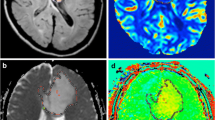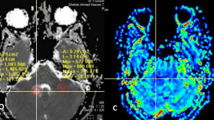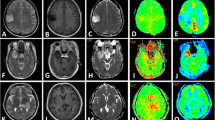Abstract
Objectives
To evaluate the added value of amide proton transfer (APT) imaging to the apparent diffusion coefficient (ADC) from diffusion tensor imaging (DTI) and the relative cerebral blood volume (rCBV) from perfusion magnetic resonance imaging (MRI) for discriminating between high- and low-grade gliomas.
Methods
Forty-six consecutive adult patients with diffuse gliomas who underwent preoperative APT imaging, DTI and perfusion MRI were enrolled. APT signals were compared according to the World Health Organization grade. The diagnostic ability and added value of the APT signal to the ADC and rCBV for discriminating between low- and high-grade gliomas were evaluated using receiver operating characteristic (ROC) analyses and integrated discrimination improvement.
Results
The APT signal increased as the glioma grade increased. The discrimination abilities of the APT, ADC and rCBV values were not significantly different. Using both the APT signal and ADC significantly improved discrimination vs. the ADC alone (area under the ROC curve [AUC], 0.888 vs. 0.910; P = 0.007), whereas using both the APT signal and rCBV did not improve discrimination vs. the rCBV alone (AUC, 0.927 vs. 0.923; P = 0.222).
Conclusions
APT imaging may be a useful imaging biomarker that adds value to the ADC for discriminating between low- and high-grade gliomas.
Key points
• Higher APT values were correlated with higher glioma grades.
• Adding the APT signal to the ADC improved glioma grading.
• Adding the APT signal to rCBV did not improve glioma grading.
• APT is a useful adjunct to the ADC for glioma grading.





Similar content being viewed by others
Abbreviations
- ADC:
-
apparent diffusion coefficient
- APT:
-
amide proton transfer
- AUC:
-
area under the curve
- BSA:
-
bovine serum albumin
- DSC:
-
dynamic susceptibility contrast-enhanced
- DTI:
-
diffusion tensor imaging
- FOV:
-
field of view
- IDI:
-
integrated discrimination index
- MRI:
-
magnetic resonance imaging
- MTRasym :
-
magnetization transfer ratio asymmetry
- rCBV:
-
relative cerebral blood volume
- RF:
-
radiofrequency
- ROC:
-
receiver operating characteristic
- ROI:
-
region of interest
- TE:
-
echo time
- TR:
-
repetition time
- WHO:
-
World Health Organization
References
Clarke J, Butowski N, Chang S (2010) Recent advances in therapy for glioblastoma. Arch Neurol 67:279–283
Bulakbasi N, Guvenc I, Onguru O et al (2004) The added value of the apparent diffusion coefficient calculation to magnetic resonance imaging in the differentiation and grading of malignant brain tumors. J Comput Assist Tomogr 28:735–746
Sugahara T, Korogi Y, Kochi M et al (1998) Correlation of MR imaging-determined cerebral blood volume maps with histologic and angiographic determination of vascularity of gliomas. AJR Am J Roentgenol 171:1479–1486
Shin JH, Lee HK, Kwun BD et al (2002) Using relative cerebral blood flow and volume to evaluate the histopathologic grade of cerebral gliomas: preliminary results. Am J Roentgenol 179:783–789
Aronen HJ, Gazit IE, Louis DN et al (1994) Cerebral blood volume maps of gliomas: comparison with tumor grade and histologic findings. Radiology 191:41–51
Ahn SS, Shin N-Y, Chang JH et al (2014) Prediction of methylguanine methyltransferase promoter methylation in glioblastoma using dynamic contrast-enhanced magnetic resonance and diffusion tensor imaging. J Neurosurg 121:367–373
Sunwoo L, Choi SH, Park C-K et al (2013) Correlation of apparent diffusion coefficient values measured by diffusion MRI and MGMT promoter methylation semiquantitatively analyzed with MS-MLPA in patients with glioblastoma multiforme. J Magn Reson Imaging 37:351–358
Pope WB, Lai A, Mehta R et al (2011) Apparent diffusion coefficient histogram analysis stratifies progression-free survival in newly diagnosed bevacizumab-treated glioblastoma. Am J Neuroradiol 32:882–889
Romano A, Calabria LF, Tavanti F et al (2013) Apparent diffusion coefficient obtained by magnetic resonance imaging as a prognostic marker in glioblastomas: correlation with MGMT promoter methylation status. Eur Radiol 23:513–520
Van Zijl P, Yadav NN (2011) Chemical exchange saturation transfer (CEST): what is in a name and what isn’t? Magn Reson Med 65:927–948
Woods M, Woessner DE, Sherry AD (2006) Paramagnetic lanthanide complexes as PARACEST agents for medical imaging. Chem Soc Rev 35:500–511
Ward KM, Aletras AH, Balaban RS (2000) A new class of contrast agents for MRI based on proton chemical exchange dependent saturation transfer (CEST). J Magn Reson 143:79–87
Zhou J, Lal B, Wilson DA et al (2003) Amide proton transfer (APT) contrast for imaging of brain tumors. Magn Reson Med 50:1120–1126
Zhou J, Payen J-F, Wilson DA et al (2003) Using the amide proton signals of intracellular proteins and peptides to detect pH effects in MRI. Nat Med 9:1085–1090
Zhu H, Jones CK, van Zijl P et al (2010) Fast 3D chemical exchange saturation transfer (CEST) imaging of the human brain. Magn Reson Med 64:638–644
Kim M, Gillen J, Landman BA et al (2009) Water saturation shift referencing (WASSR) for chemical exchange saturation transfer (CEST) experiments. Magn Reson Med 61:1441–1450
DeLong ER, DeLong DM, Clarke-Pearson DL (1988) Comparing the areas under two or more correlated receiver operating characteristic curves: a nonparametric approach. Biometrics 837–845
Pencina MJ, D’Agostino RB, D’Agostino RB, Vasan RS (2008) Evaluating the added predictive ability of a new marker: from area under the ROC curve to reclassification and beyond. Stat Med 27:157
Zhou J, Tryggestad E, Wen Z et al (2011) Differentiation between glioma and radiation necrosis using molecular magnetic resonance imaging of endogenous proteins and peptides. Nat Med 17:130–134
Sagiyama K, Mashimo T, Togao O et al (2014) In vivo chemical exchange saturation transfer imaging allows early detection of a therapeutic response in glioblastoma. Proc Natl Acad Sci 111:4542–4547
Togao O, Yoshiura T, Keupp J et al (2014) Amide proton transfer imaging of adult diffuse gliomas: correlation with histopathological grades. Neuro-Oncology 16:441–448
Park JE, Kim HS, Park KJ et al (2015) Histogram analysis of amide proton transfer imaging to identify contrast-enhancing low-grade brain tumor that mimics high-grade tumor: increased accuracy of MR perfusion. Radiology 277:151–161
Sun PZ, Benner T, Kumar A, Sorensen AG (2008) Investigation of optimizing and translating pH-sensitive pulsed-chemical exchange saturation transfer (CEST) imaging to a 3T clinical scanner. Magn Reson Med 60:834–841
Jones CK, Huang A, Xu J et al (2013) Nuclear Overhauser enhancement (NOE) imaging in the human brain at 7 T. NeuroImage 77:114–124
McVicar N, Li AX, Gonçalves DF et al (2014) Quantitative tissue pH measurement during cerebral ischemia using amine and amide concentration-independent detection (AACID) with MRI. J Cereb Blood Flow Metab 34:690–698
Zhao X, Wen Z, Huang F et al (2011) Saturation power dependence of amide proton transfer image contrasts in human brain tumors and strokes at 3 T. Magn Reson Med 66:1033–1041
Wen Z, Hu S, Huang F et al (2010) MR imaging of high-grade brain tumors using endogenous protein and peptide-based contrast. NeuroImage 51:616–622
Howe FA, Barton SJ, Cudlip SA et al (2003) Metabolic profiles of human brain tumors using quantitative in vivo 1H magnetic resonance spectroscopy. Magn Reson Med 49:223–232
Salhotra A, Lal B, Laterra J et al (2008) Amide proton transfer imaging of 9L gliosarcoma and human glioblastoma xenografts. NMR Biomed 21:489–497
Herholz K, Hölzer T, Bauer B et al (1998) 11C-methionine PET for differential diagnosis of low-grade gliomas. Neurology 50:1316–1322
Pöpperl G, Kreth FW, Mehrkens JH et al (2007) FET PET for the evaluation of untreated gliomas: correlation of FET uptake and uptake kinetics with tumour grading. Eur J Nucl Med Mol Imaging 34:1933–1942
Sakata A, Okada T, Yamamoto A et al (2015) Grading glial tumors with amide proton transfer MR imaging: different analytical approaches. J Neuro-Oncol 122:339–348
Ahn SJ, Shin HJ, Chang J-H, Lee S-K (2014) Differentiation between primary cerebral lymphoma and glioblastoma using the apparent diffusion coefficient: comparison of three different ROI methods. PLoS One 9, e112948
Acknowledgements
The authors thank Ha-Kyu Jeong (Korea Basic Science Institute, Chungcheongbuk-do, Korea) for his help with protocol optimization and valuable suggestions.
Author information
Authors and Affiliations
Corresponding author
Ethics declarations
No complex statistical methods were necessary for this paper. Institutional review board approval was obtained. Written informed consent was waived by the institutional review board. No study subjects or cohorts have been previously reported. Methodology: retrospective, observational, performed at one institution.
Funding
This research received funding from the Basic Science Research Program through the National Research Foundation of Korea (NRF) funded by the Ministry of Science, ICT & Future Planning (2014R1A1A1002716) and National Institutes of Health (P41 EB015909, R01 CA166171, R01 EB009731).
Conflict of interest
The scientific guarantor of this publication is Sung Soo Ahn. The authors of this manuscript declare no relationships with any companies whose products or services may be related to the subject matter of the article.
Electronic supplementary material
Below is the link to the electronic supplementary material.
ESM 1
(DOC 4.97 mb)
Rights and permissions
About this article
Cite this article
Choi, Y.S., Ahn, S.S., Lee, SK. et al. Amide proton transfer imaging to discriminate between low- and high-grade gliomas: added value to apparent diffusion coefficient and relative cerebral blood volume. Eur Radiol 27, 3181–3189 (2017). https://doi.org/10.1007/s00330-017-4732-0
Received:
Revised:
Accepted:
Published:
Issue Date:
DOI: https://doi.org/10.1007/s00330-017-4732-0




